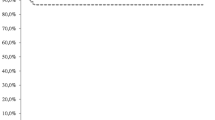Abstract
Background
Bile leaks after hepatic resection are serious complications associated with substantial morbidity and mortality. The aim of this prospective observational study was to determine the therapeutic success of endoscopic treatment of biliary leakage after liver resection.
Patients and methods
Grade B biliary leaks were considered for endoscopic treatment in patients after liver resection between 1/09 and 4/12. Endoscopic treatment (sphincterotomy only, plastic stent distal to leak or bridging) was defined as successful when the patient remained without symptoms after drain removal and without extravasation follow-up ERC 8 weeks later.
Results
Overall rate of biliary leak was 7.4 % (61/826). 35 patients with a grade B bile leak were considered for endoscopic treatment. 22 (63 %) had bile leaks that were peripherally located, and 13 (37 %) had bile leaks at central location. In 3 patients, sphincterotomy only was performed; in 19 patients, a stent distal to the leak and in 13 patients, a bridging stent was inserted. The overall success rate was 74 % (26/35 patients). Endoscopic treatment failed in 26 % (9/35), and mortality rate was 11 % (4/35). In all patients with leaks located at the right or left hepatic duct, treatment with the bridging stent was successful.
Conclusion
Endoscopic therapy for biliary leakage after liver resection is safe and effective and should be considered as a first-line therapy in patients who are suitable for an interventional, non-surgical approach. Patients with a centrally located leak who are treated with a bridging stent are more likely to benefit from endoscopic intervention.


Similar content being viewed by others
References
Mullen JT, Ribero D, Reddy SK et al (2007) Hepatic insufficiency and mortality in 1059 noncirrhotic patients undergoing major hepatectomy. J Am Coll Surg 204:854
Schroeder RA, Marroquin CE, Bute BP et al (2006) Predictive indices of morbidity and mortality after liver resection. Ann Surg 243:373
Sano T, Shimada K, Sakamoto Y et al (2006) One hundred two consecutive hepatobiliary resections for perihilar cholangiocarcinoma with zero mortality. Ann Surg 244:240
Schemmer P, Friess H, Hinz U et al (2006) Stapler hepatectomy is a safe dissection technique: analysis of 300 patients. World J Surg 30:419
Koch M, Garden OJ, Padbury R et al (2011) Bile leakage after hepatobiliary and pancreatic surgery: a definition and grading of severity by the International Study Group of Liver Surgery. Surgery 149:680
Kaffes AJ, Hourigan L, De Luca N et al (2005) Impact of endoscopic intervention in 100 patients with suspected postcholecystectomy bile leak. Gastrointest Endosc 61:269
Sandha GS, Bourke MJ, Haber GB, Kortan PP (2004) Endoscopic therapy for bile leak based on a new classification: results in 207 patients. Gastrointest Endosc 60:567–574
Dechêne A, Jochum C, Fingas C et al (2014) Endoscopic management is the treatment of choice for bile leaks after liver resection. Gastrointest Endosc 80:626
Sauer P, Chahoud F, Gotthardt D et al (2012) Temporary placement of fully covered self-expandable metal stents in biliary complications after liver transplantation. Endoscopy 44:536–538
Gotthardt DN, Weiss KH, Rupp C et al (2013) Bacteriobilia and fungibilia are associated with outcome in patients with endoscopic treatment of biliary complications after liver transplantation. Endoscopy 45:890–896
Kneuertz PJ, Pitt HA, Bilimoria KY et al (2012) Risk of morbidity and mortality following hepato-pancreato-biliary surgery. J Gastrointest Surg 16:1727
Chok KS, Ng KK, Poon RT et al (2009) Impact of postoperative complications on long-term outcome of curative resections for hepatocellular carcinoma. Br J Surg 96:81
Farid SG, Aldouri A, Morris-Stiff G et al (2010) Correlation between postoperative infective complications and long-term outcomes after hepatic resection for colorectal liver metastasis. Ann Surg 25:91–100
Sadamori H, Yagi T, Shinoura S et al (2013) Risk factors for major morbidity after liver resection for hepatocellular carcinoma. Br J Surg 100:122
Erdogan D, Busch OR, van Delden OM et al (2008) Incidence and management of bile leakage after partial liver resection. Dig Surg 25:60
Thuluvath PJ, Atassi T, Lee J (2003) An endoscopic approach to biliary complications following orthotopic liver transplantation. Liver Int 23:156
Morelli J, Mulcahy HE, Willner IR et al (2001) Endoscopic treatment of post-liver transplantation biliary leaks with stent placement across the leak site. Gastrointest Endosc 54:471
Lo CM, Fan ST, Liu CL et al (1998) Biliary complications after hepatic resection: risk factors, management, and outcome. Arch Surg 133:156–161
Bhattacharjya S, Puleston J, Davidson BR et al (2003) Outcome of early endoscopic biliary drainage in the management of bile leaks after hepatic resection. Gastrointest Endosc 57:526
Lau JY, Leung KL, Chung SC et al (1999) Endoscopic management of major bile leaks complicationg hepatic resection for hepatocellular carcinoma. Gastrointest Endosc 50:99–101
Tewani SK, Turner BG, Chuttani R et al (2013) Location of bile leak predicts the success of ERCP performed for postoperative bile leaks. Gastrointest Endosc 77:601–608
Author information
Authors and Affiliations
Corresponding author
Ethics declarations
Disclosures
Anja Schaible, Peter Schemmer, Thilo Hackert, Christian Rupp, Anna E. Schulze Schleithoff, Daniel N. Gotthardt, Markus W. Büchler and Peter Sauer have no conflicts of interest or financial relationships to disclose.
Rights and permissions
About this article
Cite this article
Schaible, A., Schemmer, P., Hackert, T. et al. Location of a biliary leak after liver resection determines success of endoscopic treatment. Surg Endosc 31, 1814–1820 (2017). https://doi.org/10.1007/s00464-016-5178-1
Received:
Accepted:
Published:
Issue Date:
DOI: https://doi.org/10.1007/s00464-016-5178-1




